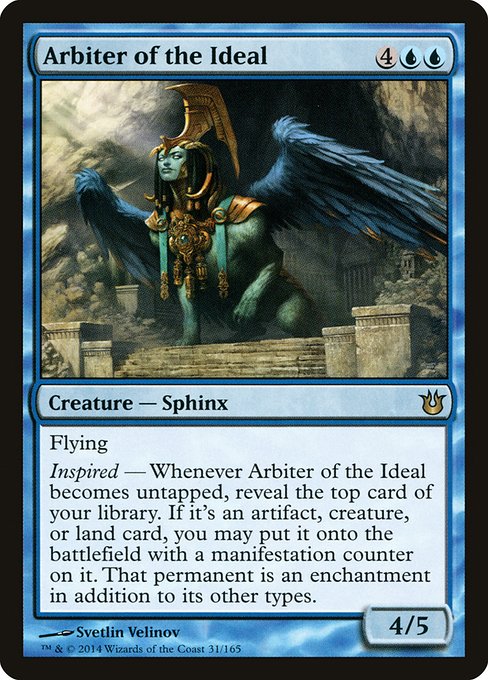
Image courtesy of Scryfall.com
Predicting Reprint Trends for Arbiter of the Ideal
Reprint odds aren’t written in stone, but they’re not random either. For Magic: The Gathering fans, a careful look at card data—rarity, set, mechanics, and historical print patterns—can yield a surprisingly sharp forecast. Arbiter of the Ideal, a blue sphinx from Born of the Gods, provides an excellent test case. This rare, with a mana cost of {4}{U}{U} and a 4/5 body, lives in a sweet spot where power, quirks, and flavor collide 🧙♂️. Its ability, Flying and Inspired, plus an unusual “manifestation-counter enchantment” twist, makes it memorable enough to matter in EDH and casual formats, yet not so dominant that Wizards would immediately slam it back into standard rotation. That combination is precisely the kind of signal statisticians look for when predicting reprint odds 🔎💎.
What drives reprint odds in practice
To forecast whether Arbiter of the Ideal might see a future printing, several levers come into play. Here’s a practical framework you can apply not just to this card, but to a broad swath of older rares and even some mythics:
- Rarity and demand: As a rare, Arbiter’s reprint odds are higher than many uncommons, but lower than iconic legends. In practice, rares recur in reprint cycles more frequently than most mythics, especially for blue cards that support control and top-deck play. The data point from its current price (roughly USD 0.19 nonfoil, USD 0.35 foil) hints at modest demand—enough to justify occasional reprints, but not so hot that it becomes a perpetual cornerstone of Standard velocity.
- Color identity and evergreen status: Blue staples recur with notable regularity, particularly in commander-focused print lines and Masters-style sets. Arbiter’s blue color identity and its control-friendly, top-deck manipulation flavor align with evergreen themes in Commander and cube environments, tipping the odds toward a future reprint in some form 🔵⚔️.
- Mechanics and flavor fit: The Inspired trigger—whenever untapped—paired with a top-deck reveal, makes the card feel both iconic and somewhat niche. Cards with distinctive mechanics often get revisited to fill gaps in new sets’ mechanical ecosystems. The ability to manifest a revealed card as an enchantment adds a twist that designers like to mine in crossover sets, commander-focused products, or special reprint lines 🎨🧭.
- Print history and block dynamics: Arbiter hails from Born of the Gods, a Theros-block release. Historically, blocks see reprints in later flagship or Commander-centric printings, but not every rare from a block will return quickly. The size and cadence of reprint cycles for Theros-based cards influence Arbiter’s odds—older blocks tend to pop up again in curated reprint cycles rather than as every-block inclusions 🗺️.
- Collectibility signals and EDH presence: The EDHREC rank (around mid-teens thousands in this case) indicates steady—but not explosive—Commander interest. That steady demand exerts pressure for reprints, especially when paired with a foil version that tends to hold value increases in the long tail. Collector interest often nudges Wizards toward a reprint in a commemorative or premium set to satisfy established players and new collectors alike 🧩🔥.
In sum, the odds are “reasonable but not guaranteed.” If you’re calculating a numerical forecast, you’d weigh arbiter-like rares with blue mana in older blocks as having a mid-range chance—more likely than not to see a reprint within a five- to seven-year horizon in some form, and possibly sooner in a Commander-focused drop or a Masters-style revival. The exact percentage is hard to nail down, but the trend lines suggest: stay tuned, especially if demand in EDH or top-deck archetypes surges in the meta 📈🎯.
Why this matters for players and collectors 🧙♂️💎
For players, predicting reprints informs both budget planning and deck-building confidence. Arbiter’s high-musion of mana cost and its top-deck manipulation makes it a tantalizing but not overbearing piece for blue control shells. In a world where every card’s reprint potential affects resale and foil desirability, knowing where Arbiter stands helps you decide whether to chase a foil now or wait for a potential reprint push. The card’s current foil price relative to nonfoil also hints at a price elasticity: foils tend to be more sensitive to reprint buzz, which can spike or soften the market depending on when and how Wizards chooses to revisit the slot 🧲🎲.
“Statistical look needs a story—and this sphinx has a story worth telling. If a reprint lands in a Commander set or a Masters-style drop, it’ll validate the approach: blues with unique mechanics survive the test of time.”
Beyond raw numbers, there’s a narrative thread: design and art. Arbiter’s artwork by Svetlin Velinov is a reminder that collector value isn’t purely about power curves. Unique visuals, mythic flavor, and evocative names spark long-tail interest that persists well after a card becomes price-stable. In MTG, aesthetics and playability often walk hand in hand, and that synergy is a durable driver of both casual love and long-term investment 💫🎨.
For those who like to plan ahead, keep an eye on Commander releases, special editions, and reprint-line announcements. If you’re new to predicting trends, start by cataloging a card’s rarity, color identity, set history, unique mechanics, and current market signals like EDH popularity and foil vs nonfoil price delta. The exercise is part art, part science—and a whole lot of MTG fun 🧭🧙♀️.
Mobile Phone Stand – Two Piece Wobble-Free Desk DisplayMore from our network
- https://blog.digital-vault.xyz/blog/post/blasting-station-memes-and-nicknames-top-mtg-community-jokes/
- https://blog.digital-vault.xyz/blog/post/valors-flagship-statistical-power-compared-to-similar-mtg-ships/
- https://blog.digital-vault.xyz/blog/post/how-digital-paper-transforms-branding-and-marketing/
- https://transparent-paper.shop/blog/post/designing-digital-collages-for-artists-a-practical-guide/
- https://crypto-acolytes.xyz/blog/post/crypto-powered-autonomous-cars-blockchains-next-driving-frontier/